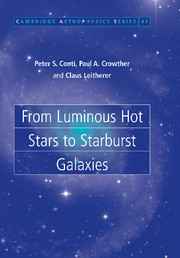Book contents
- Frontmatter
- Contents
- Preface
- Acknowledgements
- 1 Introduction
- 2 Observed properties
- 3 Stellar atmospheres
- 4 Stellar winds
- 5 Evolution of single stars
- 6 Binaries
- 7 Birth of massive stars and star clusters
- 8 The interstellar environment
- 9 From giant HII regions to HII galaxies
- 10 Starburst phenomena
- 11 Cosmological implications
- References
- Acronyms
- Symbols
- Object index
- Subject index
10 - Starburst phenomena
Published online by Cambridge University Press: 28 October 2009
- Frontmatter
- Contents
- Preface
- Acknowledgements
- 1 Introduction
- 2 Observed properties
- 3 Stellar atmospheres
- 4 Stellar winds
- 5 Evolution of single stars
- 6 Binaries
- 7 Birth of massive stars and star clusters
- 8 The interstellar environment
- 9 From giant HII regions to HII galaxies
- 10 Starburst phenomena
- 11 Cosmological implications
- References
- Acronyms
- Symbols
- Object index
- Subject index
Summary
The phrase “starburst” was used before in this volume, referring to a region with intense star formation. In this chapter we will define and discuss starbursts in more rigorous terms and relate them to the properties of the host galaxies. While luminous HII regions are often considered starbursts as well, starburst phenomena are more general and have profound cosmological implications. A major theme of this chapter, in contrast to the local focus of Chapter 9, will be the global interrelation between a starburst region and its environment. The starburst is nourished by the gas supply of the host, and it energizes the galaxy ISM with stellar winds and supernovae.
Definition of a starburst
One of the earliest uses of a term similar to “starburst” goes back to a seminal publication by Searle, Sargent, & Bagnuolo (1973). These authors added data points of many late-type galaxies to a theoretical two-color diagram which plots (B–V) against (U–B) color. Surprisingly, the galaxies had bluer colors than expected for a stellar population either evolving with steady, continuous star formation or with no star formation at all after the formation of the first stellar generation. This immediately suggested that some galaxies are observed in a special epoch: they are currently forming stars at a higher rate than previously, otherwise the bluer colors, indicative of an excess of hot stars, would not be understandable.
- Type
- Chapter
- Information
- From Luminous Hot Stars to Starburst Galaxies , pp. 229 - 265Publisher: Cambridge University PressPrint publication year: 2008

